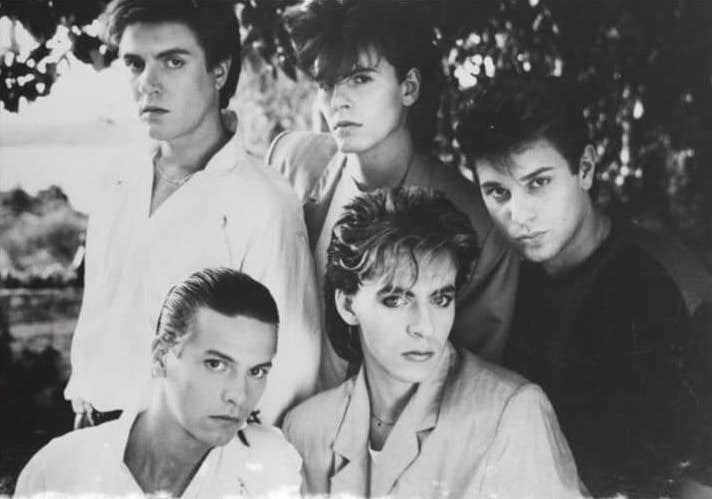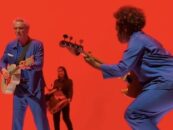 A touch of public uproar can do wonders for a career, but in Duran Duran’s case it wasn’t quite enough. When the English band released its self-titled debut in the summer of 1981, it nearly topped the album chart at home, but the offering was a non-starter in the United States. Although the group provided the then-nascent MTV with one of its first honest-to-goodness controversies in the form of its sexually charged video for “Girls on Film,” whose multiple versions included one the cable network could run during daylight hours without fear of too much outrage, even that didn’t translate to chart success for the album’s release on Capitol subsidiary Harvest Records.
A touch of public uproar can do wonders for a career, but in Duran Duran’s case it wasn’t quite enough. When the English band released its self-titled debut in the summer of 1981, it nearly topped the album chart at home, but the offering was a non-starter in the United States. Although the group provided the then-nascent MTV with one of its first honest-to-goodness controversies in the form of its sexually charged video for “Girls on Film,” whose multiple versions included one the cable network could run during daylight hours without fear of too much outrage, even that didn’t translate to chart success for the album’s release on Capitol subsidiary Harvest Records.
While that Godley and Creme-directed flashpoint may not have given the band its proper U.S. breakthrough, it did provide a valuable lesson about the combined potential of music and video, and for a group whose sonic focus was matched by its affinity for look and fashion, that synergy would soon enough unlock success. Released in late spring of 1982 and spearheaded by a single and accompanying video that showcased the best of what Duran Duran had to offer, Rio completed the band’s ascent to worldwide fame and cemented it as one of the decade’s defining acts.
 Lumped in as a New Romantic band in that movement’s dwindling days, Duran Duran fit the bill in several ways—in its bold presentation of hair, makeup and outfits, as well as the prominence of synthesizer in its arrangements. What set the group apart was the density and versatility of its pop/rock alloy, augmented by a personality all its own, an arch pretty-boy ethos that smartly avoided wimpiness.
Lumped in as a New Romantic band in that movement’s dwindling days, Duran Duran fit the bill in several ways—in its bold presentation of hair, makeup and outfits, as well as the prominence of synthesizer in its arrangements. What set the group apart was the density and versatility of its pop/rock alloy, augmented by a personality all its own, an arch pretty-boy ethos that smartly avoided wimpiness.
Rio opens with the self-assured sonic color of its title track, as portentous clutter—generated by tossing metal rods onto a piano’s strings and playing it backwards—yields to Roger Taylor’s sprightly drum propulsion adorned with Nick Rhodes’ flickering arpeggiator pulse, soon bolstered by Andy Taylor’s punctuating guitar. Sprawling and buoyant, it is infectious from the get-go, and vocalist Simon Le Bon colors inside its borders with near-detached evenness within the verses. A singer who escalates without emphasizing personality, he nonetheless offers an agreeable authority, making it largely immaterial that the lyric can only with real charity be described as holding anything in the general vicinity of meaning.
Of course, in the right setting, obscurity in the service of energy proves to be no vice. “Rio” adds up to considerably more than the sum of its parts, memorable from John Taylor’s plump bass filigree to Andy Hamilton’s juicy saxophone bits in an irresistible pop concoction. Released as the final offering from an album for which only three singles were released in the U.S., the track reached as high as #14 on the Billboard Hot 100, though the album’s success was by that time already assured.
That was thanks to the collection’s first single. Released in June 1982, “Hungry Like the Wolf” initially saw little play beyond stations in New York and Los Angeles, and initially had the look of another single embraced overseas that would fail to break the band in the U.S. As it turned out, MTV had something to say about that.
Shot by the band in Sri Lanka and offered as a sort of glam-meets-jungle adventure, the “Hungry Like the Wolf” video sported a more reserved raciness than “Girls on Film,” and was an ambitious swing at a time when MTV was loaded with videos shot on the cheap in television studios. It soon landed in what qualified as heavy rotation, playing four times a day, and gave the band a powerful beachhead in the States on a channel that was starting to make stars as much as feature them. The song entered the Billboard Hot 100 in December ’82, then proceeded to climb steadily until it reached #3 in March during a 23-week chart stay, while the video that was so instrumental to its success would win the inaugural Grammy for short form music video in 1984. With that, Duran Duran had at last arrived in America.
Related: The song is included in our feature of 13 timeless early ’80s British earworms
As introductions go, “Hungry Like the Wolf” was absolutely ideal. From the intoxicating opening laugh of Rhodes’ then-girlfriend, it races alongside electronic popcorn chitter from his Roland Jupiter-8, with Andy Taylor giving each line electric punctuation, bass adding decorative character to the undercarriage, and drums that splash when needed. Le Bon is at his most effective as he colors the groove with sharpened urgency, non-threatening yet still edgy as he grapples with the bounding pulse. Playful but serious-sounding, obscure without sounding like nonsense even if it sort of is, the song is the best distillation in its entire catalog of the band’s strengths, coalescing into something engaging, quirky and fun.
While those two singles drove much of its success, for an additional boost sparked by image one needed look no further than the album’s cover. With her bone-white face and inviting smile, the woman featured in the iconic illustration (adapted from a photo of model Marcie Hunt in the February 1981 Vogue Paris) ranks as one of the most pitch-perfect album representations ever created, giving the title track an added layer while enhancing the entire package’s baseline appeals. Created by Patrick Nagel, best known to that point for his spot illustrations in Playboy, the sleek central image accented by long, triangular violet earrings and streamers of color running in the foreground was a remarkable example of contemporary iconography that gave the band an eye-catching edge in record stores. Development began with Nagel offering the group two pieces as options, both of which would be put to work, but which was preferable for the cover was an easy choice. Even for a band that focused so much on its own appearance—and displayed powerful restraint not to put themselves front and center—it added another level to its visual vocabulary, and cemented the Nagel girl as a 1980s icon.
“My Own Way” marked a second stab at the song, which was a disco-leaning top 15 hit in the U.K. a year before its inclusion on Rio. Springy and insistent when assembled even as individual components break the surface here and there, it adds up to an appealing tapestry of complementary elements that swirls together guitar, bass and peppered keyboards while Le Bon engages with a near-shouting intensity. When the track was released as a single in Japan prior to the album’s release, its sleeve featured Nagel’s alternative to the album cover—a girl of similar appearance with a yellow flower in her hair—despite the band apparently never securing the rights to use it.
Rio did not deliver a deep well of U.S. singles, but “Save a Prayer” was released between the record’s two hits. Stacked atop a sequenced synth figure that repeats throughout and further decorative touches Rhodes supplies, its electronic breeziness with edge traces of electric guitar makes for a plush bed whose distinction comes from mellow sonic touches. Le Bon sounds in the early verses nearly noncommittal, like he is putting distance between himself and the lyric, but his finesse builds with the song and complements its overall vibe. It failed to chart in the U.S., though it was the album’s biggest hit in the U.K., climbing as high as #2.
As part of the album’s promotional strategy, the label produced videos for six of its nine tracks – including all four songs noted above. The Sri Lanka trip yielded three, which found the group singing in front of bathing elephants and in a temple for “Save a Prayer,” and Le Bon strolling portentously in a bright red scarf for “Lonely in Your Nightmare.” His performance in the latter has much in common with the recording, sung with a clinical nonchalance that sounds like observing the lyric rather than experiencing it. With bass and drums set back in its billowing atmosphere, its sparse, mellow pulse makes the most of a nice-enough hook.
The last of the album’s clips promoted “The Chauffeur,” albeit without the band’s presence. The video is an odd duck, focused on ladies in their undergarments, and shares with the song a clear intention to be arty and atmospheric that ultimately turns out to be somewhat clunky. A poem framed in a sparse electronic space, it stands apart from the rest of the record as intended, but as the record’s final track represents a chilly, impersonal close. Although the song has acquired its own fandom in the decades since its release, it is more noteworthy as a risk than an achievement.
Among the remainder of the collection, “Last Chance on the Stairway” is another curiosity. A heavily textured, propulsive meditation with minimal focus on hook, it engages briskly as guitar and bass decorations intertwine with a sprightly drum backbone. The title chant at its end sounds almost unfinished, but the whole has substantial flavor.
After a spacey beginning, “New Religion” develops into a sturdy showcase of the group’s interlocking contributions. Le Bon’s echo-trimmed vocal brings depth and Andy Taylor’s guitar a sharp edge, but John Taylor’s loping bass defines its atmosphere beneath layered vocals that work intently against one another, adding up to a sturdy, nodding embrace and extrapolation of mood. Le Bon’s strengths are most strongly in evidence when he snaps at the second verse of “Hold Back the Rain,” making hay with insistence couched in arch personality while the arrangement ascends and expands, thickened by the drum machine atop Roger Taylor’s own physical beat and Rhodes’ synth trimming that makes the tune feel more electronic than much of the band’s material.
The band’s path to U.S. success required more than its fair share of elbow grease—the entire first side of Rio was remixed to make it more palatable for the stateside market, which John Taylor would later call “the end of Duran Duran, our original idea, an underground club band.” In the end, that effort did have its desired commercial effect—the set would climb as high as #6 on the U.S. album charts, one of three consecutive top 10 releases once the band’s debut album was reissued in 1983 with adjustments that included the addition of the soon-to-be-#4 hit “Is There Something I Should Know.” For all its finagling, Rio would endure as the group’s defining record, a foundational success whose signature sound has aged as gracefully as the irresistible smile that stares out from its sleeve.
Rio is available in the U.S./worldwide here, in Canada here and in the U.K. here.
Watch Duran Duran perform the title track from Rio live in 1982
- Duran Duran’s ‘Rio’: A Defining Moment - 11/20/2025
- Pure Prairie League: ‘Bustin’ Out’—Persistence Pays Off - 10/14/2025
- John Mellencamp’s ‘Scarecrow’:The Turning Point - 08/05/2025






No Comments so far
Jump into a conversationNo Comments Yet!
You can be the one to start a conversation.